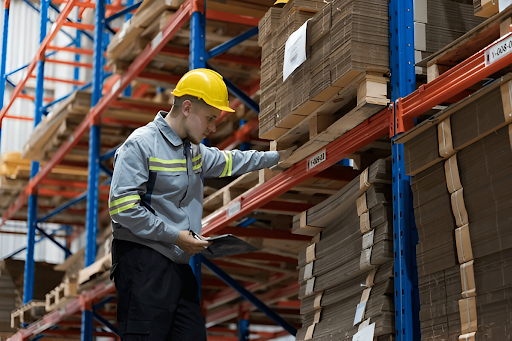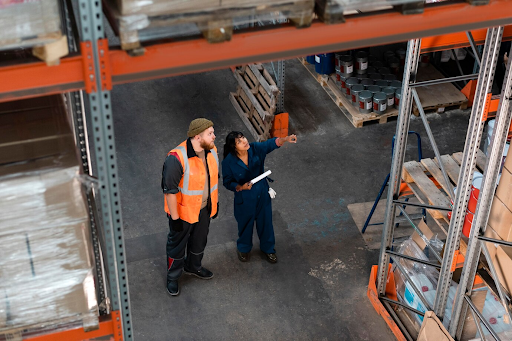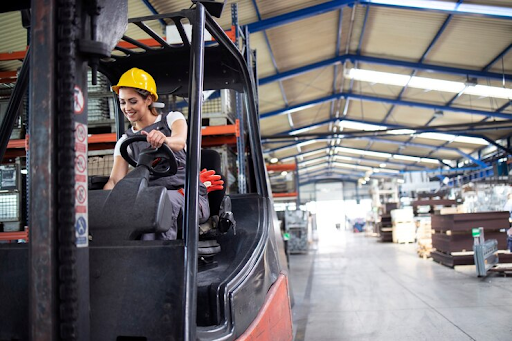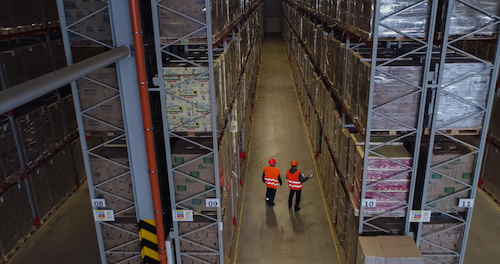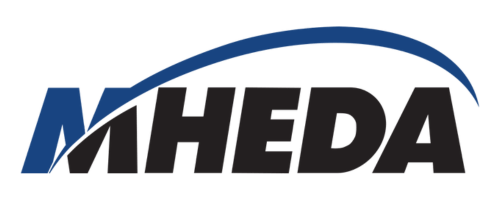Essential Pallet Racking Inspection Tips for Safety First
Warehouses are vital to logistics, and pallet racking systems are their support structure. However, pallet racking inspections often go unnoticed in warehouse safety protocols. These towering storage systems are essential for efficient inventory management and maximizing space. These systems might become dangerous if they are not regularly inspected and maintained. Even a single oversight, unnoticed damage, or overlooked wear can lead to costly accidents, worker injuries, and significant liability issues. Therefore, regular inspections are non-negotiable to identify potential problems before they escalate.
Below, we are going to share simple yet effective warehouse racking inspection tips to prioritize safety. These practical tips will guide you through everything from understanding the importance of regular assessments to knowing what to look for during inspections and an actionable pallet racking inspection checklist to help you cultivate a safe, efficient, and compliant warehouse operation.
The Importance of Pallet Racking Inspections
Pallet racking systems provide a foundation for warehouses. They optimize space, support large loads, and simplify product storage. However, given their size and the weight they support, any damage or instability might result in serious consequences. Thus, in this case, inspections are an active step to ensure the safety of workers, the protection of goods, and the performance of warehouse operations. Routine inspections ensure compliance but also nip minor issues in the bud, thus preventing them from escalating into major, costlier headaches.
Pallet racking inspections are essential for preserving the structural integrity of the storage system and preventing accidents. A hidden crack or twisted structure could cause the entire storage system to fail and collapse. Inspections encourage the early detection of weaknesses and help create a more reliable and secure workplace. Plus, regular checks boost operational efficiency. When racks are organized and damage-free, products are easy to access, which cuts down on downtime.
Potential Risks of Neglecting Warehouse Racking Inspections
There are a lot of risks associated with not inspecting pallet racking regularly, including:
- Structural Failures: Overloaded or damaged racks can collapse, causing injury or damage. This can bring operations to a halt and lead to expensive downtime.
- Falling Objects: Loose items or improperly loaded pallets can fall on in-house workers and create serious risks. In worst-case scenarios, this can lead to extreme injuries or fatalities.
- Fire Hazards: Congested exits and cluttered aisles can complicate evacuation during fire emergencies and increase the risk of casualties.
- Electrical Risks: Warehouses depend on powered equipment, but loose or exposed electrical components can create dangerous electrical hazards, all of which can be avoided with proper inspections.
Key Elements of an Extensive Pallet Racking Inspection

1) Structural Integrity and Stability
The safety of a racking system is contingent upon its structural integrity. Inspect for bent or damaged frames, loose bolts, weld cracks, and corroded joints. Rust and corrosion can silently undermine the structure’s strength over time and compromise its capability to support loads. To ensure system stability, look for any warping in beams, columns, or braces and verify that they are stable and secure.
2) Load Capacity and Distribution
Avoid overloading racks. An overloaded rack risks collapse but can also damage inventory and incur financial losses. Label the rack with proper weight limits and ensure an even distribution of loads to ensure the racks are balanced.
3) Safety Signage and Labeling
Enact standard operating procedures, such as signs, to reduce the chances of errors and accidents. Set clear and visible signage indicating load capacities, safety instructions, and hazard warnings. These signs should be clean, legible, and placed at a height that is easily visible to workers and visitors.
4) Floor and Ground Stability
Secure floor anchors are critical for preventing unexpected rack failures. Loose anchors destabilize the entire racking system and increase the collapse risk. Inspect whether the racks are anchored correctly to the floor and ensure bolts are tight and undamaged.
5) Aisle and Exit Clearance
Blocked aisles impede the operation of forklifts and other equipment, which could result in accidents. Aisles must have enough space for safe navigation and emergency egress. Keep exit paths clear of obstructions to ensure rapid and safe evacuation during emergencies.
6) Fire and Electrical Safety
Electrical hazards can be dangerous, including the risk of electrocution and fire. Therefore, timely electrical inspections are necessary to avoid fire risks and protect employees and property. Seal exposed wiring whenever possible. Check that NFPA 70E standards are followed and ensure the presence of functional fire extinguishers.
7) First Aid Preparedness
OSHA guidelines mandate that fully stocked first-aid kits should be available for workers at all times. This ensures prompt access to supplies, which is critical for responding to workplace injuries. Therefore, regularly check for expired or depleted supplies and replenish them as needed
Best Practices for Routine Pallet Racking Inspections
- Regular Scheduling: Set up an inspection schedule conducted monthly, quarterly, or annually. This helps to stay on track.
- Train Your Staff: Equip your employees with the knowledge and training to identify damage and report hazards. A well-trained workforce acts as an additional layer of safety.
- Document Inspections: Keep detailed records of inspection findings and corrective actions. This will help you track recurring issues and also cover your compliance bases.
- Hire Certified Professionals: Collaborate with certified professionals for in-depth inspections. Their expertise can help you gain deeper insights and identify hidden risks.
Legal and Compliance Standards for Pallet Racking Safety
These are some specific compliance standards that employers must obey. In the United States, the Occupational Safety and Health Administration (OSHA) is the primary regulatory body that federally regulates warehouse safety. OSHA standards mandate that employers maintain a safe work environment, which includes maintaining the integrity of pallet racking systems.
Beyond OSHA requirements, warehouse operators must also adhere to standards established by industry-leading associations. Organizations like the Rack Manufacturers Institute (RMI) and the National Fire Protection Association (NFPA) have critical guidelines for workplace safety protocols and system reliability.
The Cost of Non-Compliance
Safety regulation violations are not to be taken lightly. Violations can result in thousands of dollars in penalties, and multiple violations may lead to even higher fines and legal action. As a result of noncompliance and penalties, the company’s reputation and relationships with clients and employees can suffer.
Preparing for an OSHA Inspection
- Pre-Inspection Audit: Conduct internal audits regularly. Internal audits are an excellent approach to identify issues before they become problematic. Use inspection reports as a roadmap to remediate issues.
- Compliance with Safety Standards: Get clarity on OSHA, NFPA, and RMI guidelines to pass compliance checks without hassles.
- Emergency Preparedness: Train your staff on emergency protocols and ensure everyone is equipped with proper safety equipment and sufficiently stocked with first aid.
Let’s Build a Safety-First Warehouse Culture
Regular pallet racking check-ups are non-negotiable for maintaining a safe, efficient, and compliant warehouse. Prioritize safety and adhere to regulatory standards to safeguard your team, inventory, and operations from unnecessary risks.
Building a safety-first mindset also means empowering employees, promoting hazard reporting, and celebrating safe behaviors through open communication. Foster a culture where workers feel comfortable reporting concerns without fear of repercussions. Recognize and reward proactive safety measures to solidify this culture.
At SRSI, we are a trusted leader in warehouse automation and support the development of safety-first warehouse cultures through our comprehensive solutions. We specialize in conveyor integrations and automated storage and retrieval systems (AS/RS) to optimize inventory flow, customize slotting and storage systems, and improve order processing and inventory control. We help maximize labor and equipment utilization by implementing industry-leading safety practices.
Enhance operational efficiency and reinforce a strong, sustainable workplace safety with us by your side.
Frequently Asked Questions
1) How often should pallet racking inspections be conducted?
Routine inspections can be planned monthly, quarterly, or annually, depending on warehouse activity and the risk factors present. In case of collisions or visible damage, you should schedule an immediate inspection for your facility.
2) Who should conduct pallet racking inspections?
Routine checks and inspections can be performed by trained in-house staff. However, certified professionals are recommended for comprehensive, in-depth inspections to identify hidden risks and ensure compliance.
3) What are the most common issues found during pallet racking inspections?
Common issues include rusted joints, overloaded racks, loose bolts, bent or damaged frames, inadequate weight distribution, missing safety signage, and obstructed aisles or exits.
4) What are the consequences of neglecting pallet racking inspections?
Ignoring inspections increases the risk of structural failures, falling objects, fires, electrical problems, and workplace injuries. This can lead to fines, lawsuits, damage to a company’s reputation, and even production downtime.
5) How can we ensure compliance with OSHA and other safety standards?
Understand OSHA, RMI, and NFPA guidelines and stay informed about their updates. To ensure compliance, conduct regular inspections, train staff on hazard recognition and safety practices, document inspection findings, and collaborate with certified professionals.
6) What steps should be taken if damage is found during an inspection?
If damage is found, mark the area unsafe, restrict access, and start repairs immediately. To avoid recurring incidents, document the problem, inform all pertinent staff, and adjust inspection procedures from that point onward.
 Skip to main content
Skip to main content

